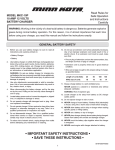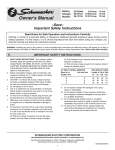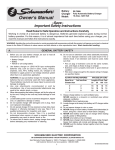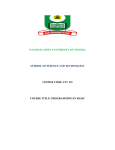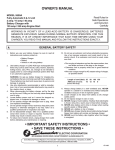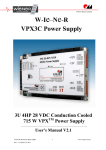Download Schumacher Electric SF-200-30 Owner`s manual
Transcript
Battery Charger Models: Owner's Manual SF-125A, SF-1275A, SF-5212A, SF-520MA Battery Charger –Save– Important Safety Instructions Read Rules for Safe Operation and Instructions Carefully Working in vicinity of a lead-acid battery is dangerous. Batteries generate explosive gases during normal battery operation. For this reason, it is of utmost importance that each time before using your charger, you read this manual and follow the instructions exactly. WARNING: Handling the cord on this product or cords associated with accessories sold with this product, will expose you to lead, a chemical known to the State of California to cause cancer and birth defects or other reproductive harm. Wash hands after handling. A. 1. 2. 3. 4. 5. 6. 7. 8. 9. GENERAL BATTERY SAFETY Before you use your battery charger, be sure to read all instructions and cautions printed on: • Battery Charger • Battery • Vehicle or unit using battery Use battery charger on LEAD ACID type rechargeable batteries only, such as used in autos, trucks, tractors, airplanes, vans, RV's, trolling motors, etc. Charger is not intended to supply power to low-voltage electrical system other than in an automotive application. WARNING: Do not use battery charger for charging drycell batteries that are commonly used with home appliances. These batteries may burst and cause injury to persons and damage to property. Use only attachments recommended or sold by manufacturer. Use of non-recommended attachments may result in fire, electric shock, or injury. When disconnecting the battery charger, pull by the plug not by the cord. Pulling on the cord may cause damage to cord or plug. Locate battery power cord so it cannot be stepped on, tripped over, or subjected to damage or stress. Do not operate charger with damaged cord or plug. Have cord replaced immediately. Do not operate charger if it has received a sharp blow, been dropped, or otherwise damaged in any way. Take it to a qualified professional for inspection and repair. Do not disassemble charger. Take it to a qualified professional when service or repair is required. Incorrect reassembly may result in electric shock or fire. To reduce risk of electric shock, unplug charger from outlet before attempting any maintenance or cleaning. 10. Do not use an extension cord unless absolutely necessary. Use of an improper extension cord could result in fire or electric shock. If an extension cord must be used, make sure that: • Pins on plug of extension cord are the same number, size, and shape as those of plug on charger. • Extension cord is properly wired and in good electrical condition. • Wire size is large enough for AC ampere rating of charger, as specified below: Length of cord (feet): 25 50 100 150 AWG size of cord: 16 14 10 8 11. Always charge battery in a well ventilated area. NEVER operate in a closed-in or restricted area without adequate ventilation. WARNING: Risk of explosive gas. 12. Locate charger as far away from battery as DC charger cables permit. 13. Do not expose charger to rain or snow. 14. NEVER charge a frozen battery. If battery fluid (electrolyte) is frozen, bring into a warm area to thaw before charging. 15. NEVER allow battery acid to drip on charger when reading specific gravity or filling battery. 16. NEVER set a battery on top of charger. 17. NEVER place charger directly above battery being charged. Gases from battery will corrode and damage charger. 18. NEVER touch the battery clamps together when the charger is energized. SCHUMACHER ELECTRIC CORPORATION 801 BUSINESS CENTER DRIVE • MOUNT PROSPECT, ILLINOIS 60056-2179 Send Warranty Product Repairs to: 1025 E. Thompson, Hoopeston, IL 60942-0280 Call Customer Service if you have questions: 1-800-621-5485 In Canada, for warranty claims and replacement, please return item to place of purchase during warranty period with receipt of purchase. 1 00-00-000634/0103 B. 1. 2. 3. 4. WARNING: Wear complete eye protection and clothing protection, when working with lead-acid batteries. Make sure someone is within range of your voice or close enough to come to your aid when you work with or near a lead-acid battery. Have plenty of fresh water and soap nearby for use if battery acid contacts skin, clothing, or eyes. If battery acid contacts skin or clothing, wash immediately with soap and water. Avoid touching your eyes while working with a battery. Acid particles (corrosion) may get into your eyes! If acid enters your eye, immediately flood eye with running cold water for at least 10 minutes. Get medical attention immediately. C. 1. 2. 3. 4. 5. 6. 7. 8. PERSONAL PRECAUTIONS AND SAFETY 5. 6. 7. 8. Remove all personal metal items such as rings, bracelets, necklaces, and watches when working with a lead-acid battery. A lead-acid battery can produce a short-circuit current high enough to weld a ring (or the like) to metal, causing a severe burn. Take care not to drop a metal tool or other metal onto the battery. Metal may cause sparking or short circuit the battery or another electrical devise. Sparking may cause an explosion. Always operate battery charger in an open well ventilated area. NEVER smoke or allow a spark or flame in the vicinity of the battery or engine. Batteries generate explosive gases! PREPARING TO CHARGE Make sure you have a 6 or 12 volt lead-acid battery. Check car owner manual to make sure. Clean battery terminals. Take care to keep corrosion from coming in contact with your eyes. If required, add distilled water in each cell until battery acid reaches levels specified by battery manufacturer. This helps purge excessive gas from cells. Do not overfill. For a battery without cell caps, carefully follow manufacturer's recharging instructions. Study all battery manufacturer's specific precautions, such as removing or not removing cell caps while charging, and recommended rates of charge. Be sure area around battery is well ventilated while battery is being charged. Gas can be forcefully blown away by using a piece of cardboard or other non-metallic material as a fan. If necessary to remove battery from vehicle to charge, always remove grounded terminal from battery first. Make sure all accessories in the vehicle are off, so as not to cause an arc. A marine (boat) battery must be removed and charged on shore. To charge it on board requires equipment specially designed for marine use. Select charge rate suitable for the battery being charged (2 or 15 Amps). GROUNDED OUTLET ADAPTER METAL SCREW COVER OF GROUNDED OUTLET BOX (A) (B) GROUNDING PIN Grounding Methods When charging a battery in a boat, RV or motor home always connect one lead of the output cable to the battery. Never connect to a remote receptacle or other means for the purpose of remotely charging the battery. The wires may be inadequate for handling the charge current of this charger and may over heat. Often these wires are bundled in with other wires which could be damaged and lead to a direct short across the battery and charger. If this occurs a fire can result, equipment and appliances operated from the battery may also be damaged. DANGER - Before using adapter as illustrated, be certain that center screw of outlet plate is grounded. The green-colored rigid ear or lug extending from adapter must be connected to a properly grounded outlet - make certain it is grounded. If necessary, replace original outlet cover plate screw with a longer screw that will secure adapter ear or lug to outlet cover plate and make ground connection to grounded outlet. GROUNDING AND AC POWER CORD CONNECTION INSTRUCTIONS - Charger should be grounded to reduce risk of electric shock. Charger is equipped with an electric cord having an equipment-grounding conductor and a grounding plug. The plug must be plugged into an outlet that is properly installed and grounded in accordance with local codes and ordinances. Use of an adapter plug is not allowed in Canada. DANGER - Never alter AC cord or plug provided - if it will not fit outlet, have proper outlet installed by a qualified electrician. Improper connection can result in a risk of electric shock. This battery charger is for use on a nominal 120-volt circuit, and has a grounding plug that looks like the plug illustrated in sketch A. A temporary adapter, which looks like the adapter illustrated in sketch B, may be used to connect this plug to a two-pole receptacle as shown in sketch B if a properly grounded outlet is not available. The temporary adapter should be used only until a properly grounded outlet can be installed by a qualified electrician. During operation do not place the charger or its cables on the vehicle seat or carpeting. 2 METER AND SWITCH FUNCTIONS MODEL: SF-125A TYPICAL DISPLAY FOR A FULLY CHARGED BATTERY AT THE 15 AMP CHARGE RATE Ä 12 VOLT 125 AMP ENGINE START 6 VOLT 15 AMP MANUAL Ä 12 VOLT 2 AMP TYPICAL DISPLAY FOR A DISCHARGED BATTERY AT THE 15 AMP RATE START Percent % 100 75 50 25 FULL CHARGE (GREEN © INDICATOR) 6 VOLT 125 VOLT ENGINE START The START area of the meter is reserved to indicate when a high rate of current is being drawn from the charger. It is normal for the meter pointer to be in this area while cranking a vehicle. VOLT/AMP SELECTOR FOR MANUAL OPERATION (For Automatic operation, set dial to any position except (OFF.) When using the 2 amp charge rate the meter may indicate some activity but doesn’t have the resolution to accurately display the battery’s state of charge. For this reason you should depend on the full charge light indicator. OFF: This position disconnects AC power supplied by your outlet from the rest of the charger. 6 VOLT 15 AMP: Used for charging medium and large size 6 volt batteries, typical application are for crank starting of farm equipment and antique automobiles. Do not charge small batteries such as used in motorcycles, lawn and garden equipment. ENGINE START: 12 VOLT 2 AMP: The 2 Amp charge rate is recommended for small batteries, motorcycles etc. If used for maintaining the full charge level of larger batteries, limit the charge period to a few days at a time. This amperage setting is both automatic or manual. See switch below. 12 VOLT 125 AMP START: Used for crank starting of 12 volt vehicles. The engine start position should not be used for battery charging, doing so will cause the charger to over heat and thus protect itself by cycling off and on. 12 VOLT 15 AMP: Use for charging medium and large size batteries. This most popular charge rate can operate in either the Automatic or Manual mode of charging. See Automatic/ Manual 3-way Switch. 6 VOLT 125 AMP START: Used for crank starting of 6 volt vehicles. NOTE: Not recommended for use on 8 volt systems. BATTERY TYPE SWITCH 2 AMP, 12 VOLT AUTOMATIC L MANUAL L REVERSED HOOKUP (RED INDICATOR) METER: The meter indicates the amount of current measured in amperes that is being drawn from the charger by a battery. In the 15 Amp charge rate a typical discharged battery may initially draw more than 15 Amps during the first few minutes of charge. As the battery continues to charge current should gradually taper to within 6 to 8 amps at full charge. 12 VOLT 15 AMP OFF 0 © D. L 15 AMP, 12 VOLT AUTOMATIC 3 1. Set 3-way switch to “MANUAL” setting. 2. Connect the battery charger as outlined in Section H. 3. For best results charge the battery for 10 minutes before cranking the engine at 15 amp setting. 4. Set the rotary charge rate selector switch to the 125 Amp start position that matches the voltage of the vehicle’s battery – 6 or 12 volt. 5. Crank the engine for 5 seconds, if the engine fails to start, set the charge rate switch to the 15 Amp rate and charge the battery for the next 5 to 10 minutes before cranking again. 6. If the engine fails to start after several tries, there maybe a problem elsewhere in the vehicle. E. BATTERY CHARGER CONTROLS OPERATION – Model SF-1275-A OPERATION – SF-520-MA Two switches permit Battery Type and Charge Rate selection. This charger has two switches. Switch #1 permits selection of either Conventional or Maintenance Free and Deep Cycle batteries. If you are not sure of your battery type, use the (Regular) Conventional Setting. Switch #1 Mode 1--Manual Position: Use for charging in 2 amp or 10 amp Charge Rates on 12 volt batteries only. This charging must be monitored and charging manually stopped when the battery is charged. Overcharging will damage the battery. Switch #2 (3 Charge Rate Modes) Mode 1 -- Select the 2 amp automatic setting for 12 volt smaller (<31 AH (Ampere Hour)) or to warm larger lead-acid batteries. Mode 2--Automatic Position for Conventional Batteries. If you are not sure of your battery type, use the (Regular) Conventional Setting. Mode 2 -- Select 12 amp automatic for larger 12 volt batteries for a faster charge. Mode 3--Automatic Position for Maintenance Free and Deep Cycle batteries. Mode 3 -- Select 75 amp Engine Start to assist in engine cranking of 12 volt systems. DO NOT use on 6 volt systems. Use the 75 amp engine start position for cranking automobiles or light trucks. Use only with battery in the vehicle. This will reduce the chance of damaging sensitive electronic equipment in the vehicle. BATTERY TYPE CHARGE RATE (SWITCH #1) (SWITCH #2) L L REGULAR BATTERIES DEEP CYCLE BATTERIES L 2 AMP L Switch #2 (2 Charge Rate Modes) Select either 2 amp Charge Rate for small batteries or 10 amp Charge Rate for larger batteries. NOTE: A buzz, or hum is normal when the output cables have been disconnected and the AC power cord is still connected to an electrical source (i.e. wall outlet). L 12 AMP AUTOMATIC FOR M MAINTENANCE FREE AND DEEP CYCLE (SWITCH #1) BATTERIES MANUAL M 75 AMP ENGINE START L AUTOMATIC FOR CONVENTIONAL LOW MAINTENANCE BATTERIES OPERATION – Model SF-5212-A Two switches permit Battery Type and Charge Rates selection Switch #1 permits selection of either Conventional or Maintenance Free and Deep Cycle batteries. If you are not sure of your battery type, use the (Regular) Conventional Setting. Switch #2 (3 Charge Rate Modes) Mode 1 -- Select the 2 amp automatic setting for 12 volt smaller (<31 AH (Ampere Hour)) or to warm larger lead-acid batteries. Mode 2 -- Select 10 amp automatic for larger 12 volt batteries for a faster charge. Mode 3 -- Select 50 amp Engine Start to assist in engine cranking of 12 volt systems. DO NOT use on 6 volt systems. Use the 50 amp engine start position for cranking automobiles or light trucks. Use only with battery in the vehicle. This will reduce the chance of damaging sensitive electronic equipment in the vehicle. BATTERY TYPE CHARGE RATE (SWITCH #1) (SWITCH #2) L CONVENTIONAL AND LOW MAINTENANCE BATTERIES L MAINTENANCE FREE AND DEEP CYCLE BATTERIES L L L 2 AMP 10 AMP 50 AMP ENGINE START 4 CHARGE RATE (SWITCH #2) L 2 AMP L 10 AMP F. READING METER FOR: SF-1275A, SF-5212A, SF-520MA CHARGE % 100 FULL CHARGE 75 50 25 0 POWER ON FULLY DISCHARGED BATTERY Initial charge current to the battery is typically 10 amps. The needle points toward the 25% mark. (SF-520MA has one LED, Full Charge) G. 1. CHARGE % 100 FULL CHARGE 2. 3. 4. 5. 6. 7. 8. CHARGE % 100 75 FULL CHARGE APPROACHES FULL CHARGE Charge current to the battery is typically 5 amps. The needle points toward the 100% mark. 50 25 0 POWER ON FULLY CHARGED BATTERY Charge current to the battery is 0 amps. And, the Full Charge green LED glows. The needle points toward the Full Charge LED. DC CONNECTION PRECAUTIONS 2. Attach clamps to battery posts and twist or rock back and forth several times to make a good connections This tends to keep clamps from slipping off terminals and helps to reduce risk of sparking. FOLLOW THESE STEPS WHEN BATTERY IS INSTALLED IN VEHICLE A SPARK NEAR BATTERY MAY CAUSE BATTERY EXPLOSION TO REDUCE RISK OF SPARK NEAR BATTERY: 1. 50 25 0 POWER ON Connect and disconnect DC output camps only after setting any charger switches to off position and removing AC cord from electric outlet. Never allow clamps to touch each other. H. 75 GROUND (NEG) Position AC and DC cords to reduce risk of damage by hood, door, or moving engine part. Stay clear of fan blades, belts, pulleys, and other parts that can cause injury to persons. Check polarity of battery posts. POSITIVE (POS, P,+) battery post usually has larger diameter than NEGATIVE (NEG, N, -) post. Determine which post of battery is grounded (connected to the chassis). If negative post is grounded to chassis (as in most vehicles), see No. 5. If positive post is grounded to the chassis, see No. 6. For a negative-grounded vehicle, connect POSITIVE (RED) clamp from battery charger to POSITIVE (POS, P,+) ungrounded post of battery. Connect NEGATIVE (BLACK) clamp to vehicle chassis or engine block away from battery. Do not connect clamp to carburetor, fuel lines, or sheetmetal body parts. Connect to a heavy gage metal part of the frame or engine block. (Figure 7) For a positive-grounded vehicle, connect NEGATIVE (BLACK) clamp from battery charger to NEGATIVE (NEG, N, -) ungrounded post of battery. Connect POSITIVE (RED) clip to vehicle chassis or engine block away from battery. Do not connect clamp to carburetor, fuel lines, or sheetmebl body parts. Connect to a heavy gage metal part of the frame or engine block. (Figure 8) When disconnecting charger, disconnect AC cord, remove clamp from vehicle chassis, and then remove clamp from battery terminal, in that order. See charge period for length of charge information. FIGURE 7 CONNECTION TO NEGATIVE GROUNDED BATTERY 5 I. FOLLOW THESE STEPS WHEN BATTERY IS OUTSIDE VEHICLE A SPARK NEAR THE BATTERY MAY CAUSE BATTERY EXPLOSION. TO REDUCE RISK Of A SPARK NEAR BATTERY: 1. 2. 3. 4. 5. 6. 7. POSITIVE Check polarity of battery posts. POSITIVE (POS, P,+) battery post usually has a larger diameter than NEGATIVE (NEG, N, -) post. Attach at least a 24-inch-long 6-gauge (AWG) insulated battery cable to NEGATIVE (NEG, N, -) battery post ( not provided). Connect POSITIVE (RED) charger clamp to POSITIVE (POS, P,+) post of battery. Position yourself and free end of cable as far away from battery as possible - then connect NEGATIVE (BLACK) charger clamp to free end of cable. Do not face battery when making final connection. When disconnecting charger, always do so in reverse sequence of connecting procedure and break first connection while as far away from battery as practical. A marine (boat) battery must be removed and charged on shore. To charge a battery on the boat requires equipment specially designed for marine use. J. NEGATIVE CHARGER BATTERY 24" 6 GAUGE CABLE POWER CORD TO GROUNDED POWER OUTLET FIGURE 8 CONNECT NEGATIVE BATTERY CLIP TO 24 INCH CABLE END AC POWER CORD CONNECTION INSTRUCTIONS DANGER - Never alter AC cord or plug provided - if it will not fit outlet, have proper outlet installed by a qualified electrician. Improper connection can result in a risk of an electric shock. This battery charger is for use on a nominal 120-volt 60 HZ circuit. K. 1. OPERATION INSTRUCTIONS These battery chargers are equipped with a self-resetting circuit breaker. This device protects the charger from temporary overloads. In the event of an overload, the circuit breaker will trip open, and after a short cooling off period will reset automatically. this process is known as cycling and can be recognized by an audible clicking sound. L. 2. These battery chargers are equipped with an electronic control circuit which automatically governs the charge rate to your battery. The charger will satisfactorily charge Maintenance Free and Conventional batteries. OUTPUT VOLTAGE These chargers are for use with 12 volt lead-acid batteries only except for the SF-125A. M. CHARGE RATE SWITCH For smaller batteries, 30 AH (ampere hour) or less, use 2 AMP setting. Small batteries may not be able to accept the potential of the 10 AMP setting. Unconverted energy will result in excess heat which the battery may not be able to dissipate, thus resulting in damage to the battery. For larger batteries either setting may be used. 6 N. 1. INDICATION OF PROPER OPERATION TO A DISCHARGED BATTERY BUT OTHERWIDE IN GOOD CONDITION 12 AMP setting: The initial charge current should be 12 AMP’s gradually tapering throughout the charge cycle to 5 Amp’s. Though not indicated, battery voltage will gradually rise to approximately 15 volts, then hold constant throughout remainder of charge cycle. When the battery reaches 15 volts and charge current drops to 5 AMP’s the charger will turn off. Initially the battery voltage will drop from its 15 volt level fairly quickly. When 13 volts is reached, the charger will again turn on, until the 15 volt, 5 AMP condition is met. O. 2. 3. CHARGE PERIOD The approximate required time to bring a battery to full charge state depends upon the number of ampere-hours (AH) depleted from the battery. AH’s are determined by multiplying the number of hours by the number of AMPS supplied to a load. 2. 3. For example - If a load was connected to a battery, which drew 7 AMPS for a period of 5 hours, the battery will have supplied 35 AH . The approximate recharge time would then be calculated by dividing the 35 AH depleted from the battery, by the ampere charge rate of the charger. To allow for tapering off of the charge rate, add 25 percent to the charge time. 4. Indications of a fully charged battery are: 1. 5. When the meter indicates an intermittent current flow to the battery. P. As this action continues, ON time will decrease to a few seconds while OFF time increases to a range of several minutes to an hour. ON/OFF times vary with size, type and condition of battery. 2 AMP setting ON/OFF action is a function of battery voltage only, otherwise identical to 12 AMP setting. At no time during the charge cycle should there be any sign of vigorous bubbling of the battery fluid. STORAGE Store battery charger in a dry area. 7 A hydrometer reading of the specific gravity of the electrolyte (fluid) of a battery in good condition should be between 1.250 and 1.285. When a battery reaches 80-85% of full charge, bubbles will appear on the surface of the fluid. As the battery nears full charge, bubbling will become more noticeably active. The time required to charge two 6-volt batteries connected in series will be the same as for one 12-volt battery of equivalent size. NOTE: This charger will shut off when the battery is fully charged and will turn back on automatically when the battery needs to be charged again. Do not charge two 12-volt batteries in parallel. Q. TROUBLESHOOTING The battery charger is designed to work automatically. However, If a problem does occur, check the following: PROBLEM POSSIBLE CAUSE SOLUTION No meter reading. Connections are reversed. With charger unplugged, reverse clips and reconnect (rock back and forth to bite in). Poor electrical connection. Clean clips and battery posts and reconnect (roll back and forth to bite in). AC outlet is dead. Plug in a lamp or other appliance to check for voltage. Battery is defective (will not accept charge). Have battery checked. Battery recently used in vehicle and is fully charged. Battery does not need charging. Charger will not turn on (when properly connected to power. (If battery is in vehicle turning on headlights will lower battery voltage in a few seconds and charger should then turn on.) Charger will not turn OFF. Battery has problem and will not take full charge. Have battery checked. Meter needle pulses (fluctuates) every few seconds AFTER THREE HOURS without slowing down. Two or more batteries connected in parallel. Do not parallel charge. Battery of 200 ampere hours or larger. Requires more time to charge: continue charging. Battery is connected to applicaton that draws a small current (such as an autodome light). Meter needle moves to extreme right, remains a short time, then returns to zero, accompanied by a clicking sound. Severely discharged battery (but otherwise good battery). Allow charging to continue until battery has recovered sufficiently to take a charge (Circuit breaker will continue to cycle and needle will swing side to side until battery has recovered). Battery is defective (will not accept charge). Have battery checked. Charger is cycling after circuit breaking overload. Wait until charger automatically resets itself (DO NOT RETURN FOR SERVICE). LIMITED WARRANTY SCHUMACHER ELECTRIC CORPORATION, 801 BUSINESS CENTER DRIVE, MOUNT PROSPECT, ILLINOIS 60056-2179 MAKES THIS LIMITED WARRANTY TO THE ORIGINAL PURCHASER AT RETAIL OF THIS PRODUCT. THIS LIMITED WARRANTY IS NOT TRANSFERABLE. THIS IS THE ONLY EXPRESS LIMITED WARRANTY AND THE MANUFACTURER NEITHER ASSUMES NOR AUTHORIZES ANYONE TO ASSUME OR MAKE ANY OTHER OBLIGATION TOWARDS THE PRODUCT OTHER THAN THIS EXPRESS LIMITED WARRANTY. THE MANUFACTURER MAKES NO WARRANTY OF MERCHANT ABILITY OR FITNESS FOR PURPOSE OF THIS PRODUCT AND EXPRESSLY EXCLUDES SUCH FROM THIS LIMITED WARRANTY. Schumacher Electric Corporation warrants this battery charger for two years from date of purchase of retail against defective material or workmanship. If such should occur the unit will be repaired or replaced at the option of the manufacturer. It is the obligation of the purchaser to forward the unit together with proof of purchase, transportation and/or mailing charges prepaid to the manufacturer or its authorized representative. SOME STATES DO NOT ALLOW THE EXCLUSION OR LIMITATION OF INCIDENTAL OR CONSEQUENTIAL DAMAGES OR LENGTH OF IMPLIED WARRANTY SO THE ABOVE LIMITATIONS OR EXCLUSIONS MAY NOT APPLY TO YOU. This limited warranty is void if the product is misused, subjected to careless handling, or repaired by anyone other than the factory or other authorized factory representative. THIS WARRANTY GIVES YOU SPECIFIC LEGAL RIGHTS, AND YOU MAY ALSO HAVE OTHER RIGHTS WHICH VARY FROM STATE TO STATE. The manufacturer makes no warranty other than this limited warranty and expressly excludes any implied warranty including any warranty for consequential damages. 8








